Water Worship: Exploring Sacred Aquatic Traditions Globally
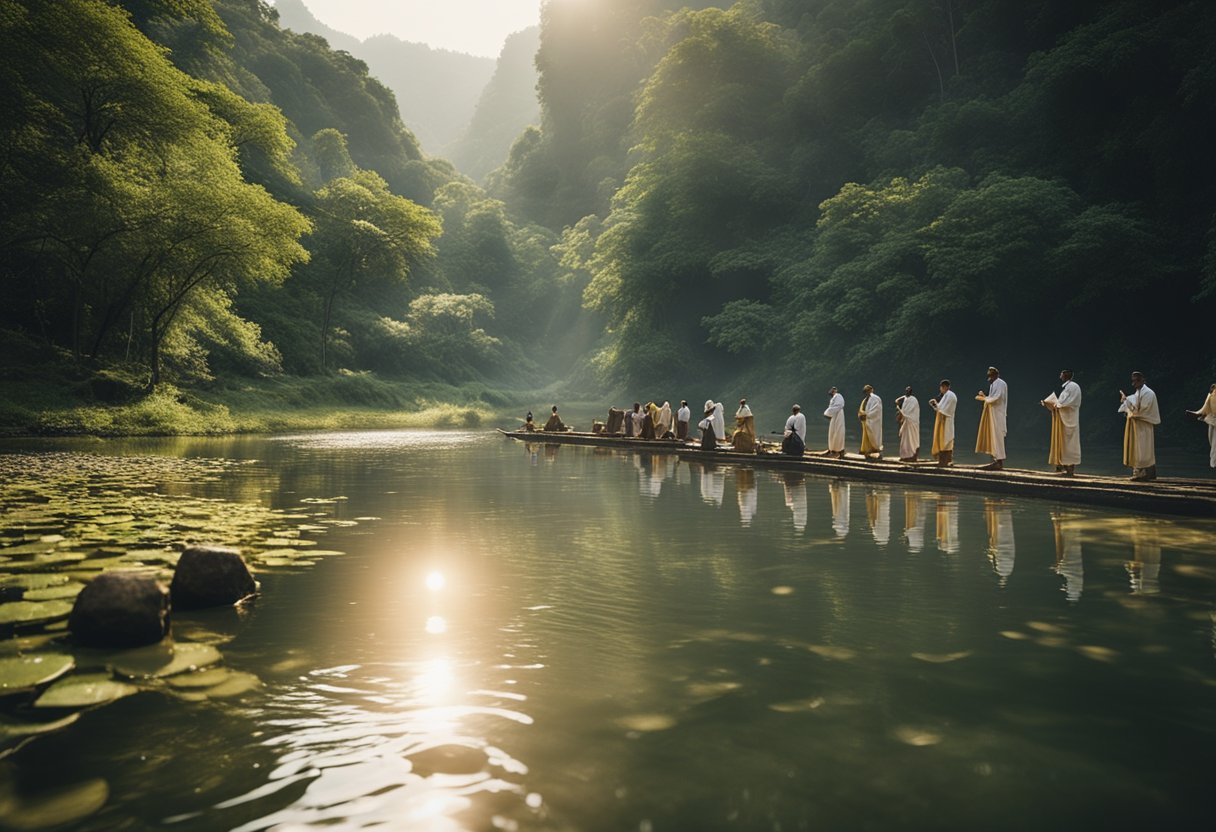
Updated On: April 23, 2024 by Yomna Salah
Across cultures and throughout history, water has been venerated for its life-sustaining properties and spiritual significance. In many parts of the world, rivers and lakes are not merely bodies of water but sacred entities in their own right. These water bodies are often central to cultural narratives and are interwoven with the ritualistic fabric of the societies that revere them. The worship of water stems from its perceived purity and its role as a source of life, leading to its sacred status in various religions and communities.
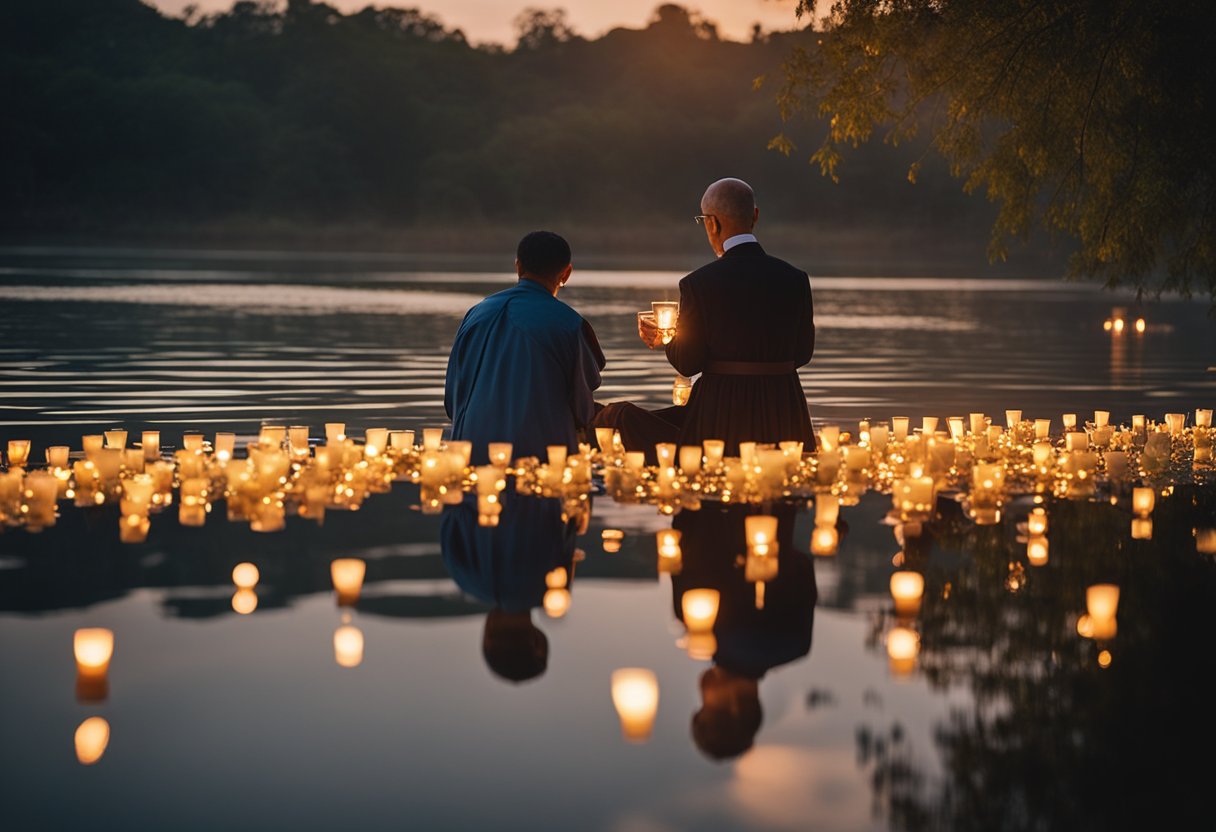
Traditions of water worship manifest in numerous forms, from grand ceremonies to daily rituals carried out with great reverence. The rituals conducted on the banks of these sacred waters often symbolise purification, enlightenment, and a harmonious connection between humanity and nature. Understanding these cultural practices provides insight into the profound relationship between societies and their natural environments, illustrating how the veneration of water can lead to a greater appreciation and conservation of this essential resource.
Table of Contents
Historical Context of Water Worship
From the Ganges to the Nile, sacred waters have been central to religious rites and cultural practices for millennia. Ritual purity is essential in Hinduism, with holy rivers like the Ganges viewed as purifiers of the soul. Pilgrims flock to these sites to perform ceremonies and immerse themselves, hoping for spiritual benefits.
The act of baptism in Christianity, symbolising purification and rebirth, often takes place in water. Rivers and lakes hold a special sanctity, embodying both physical and spiritual cleansing. Baptismal sites, such as the Jordan River, where Jesus was baptised, remain pivotal to the devout.
Buddhism also holds water in high significance, with rituals including the pouring of water to transfer merit to deceased spirits. In many Buddhist traditions, water represents the fluidity and impermanence of life, which is central to its teachings.
The Shinto religion of Japan venerates waterfalls and springs, which embody the divine spirit, or Kami. Ritual purification, or misogi, often involves water to cleanse worshippers before approaching sacred spaces.
Similarly, in many Native American traditions, water is not only a resource but a living entity that commands respect and plays a vital role in ceremonial life. Sites like the Colorado River and the Great Lakes are held in reverence, incorporating these waters into various spiritual practices.
Through these observations, we see a tapestry of beliefs unified by a reverence for water—each culture finding its unique expression while acknowledging its universal significance.
Sacred Rivers in Global Cultures
Throughout the world, sacred rivers hold profound spiritual significance within various cultures. In Asia, the Ganges River, revered by Hindus, is seen as the embodiment of the goddess Ganga. Pilgrims flock to its banks for purification, believing its waters have the ability to cleanse sins and aid in the path to enlightenment.
The concept of sacred rivers extends beyond the Ganges in Asia to the continent of Africa, where rivers like the Nile have been central to both religious beliefs and daily life for millennia. These rivers are often intertwined with creation stories and rituals of native peoples, reflecting their deep connection to the natural world.
- Rivers: Lifelines of civilisations, worshipped and revered.
- Ganga: Associated with purity and worship in Hinduism.
- Goddess Ganga: Deified as a divine purifier.
- Hindus: Consider rivers as holy and integral for spiritual practices.
- Asia: Home to many sacred rivers, from the Ganges to the Yangtze.
- Africa: Features rivers with rich spiritual narratives.
- Spiritual significance: Rivers symbolise cleansing, life and the divine.
- Religious beliefs: Reverence for rivers is evident in rituals and festivals.
- Sacred rivers: Centrepieces in religious ceremonies and community life.
The veneration of these waterways is often celebrated through elaborate festivals, where the community comes together to pay homage to these pivotal elements of their culture. The bond between people and sacred rivers transcends simple geography, serving as a vital part of their heritage and identity.
Lake Worship and Indigenous Traditions
In many cultures, lakes are more than just bodies of water; they’re keystones of spiritual life and community. Traditionally, indigenous peoples have held lakes in high regard, incorporating them into their religious traditions and cosmological beliefs.
Lake Titicaca, which spans the border between Peru and Bolivia, is a prime example of such a sacred site. For the Incas and their descendants, it was the birthplace of the sun and the first Incas, and thus, it was a site of immense spiritual significance. Often, traditional offerings are given here, highlighting the reverence maintained for this natural site.
Native American tribes also engage in lake worship. Sacred rituals frequently take place on the shores, with the water being treated as a living entity that communicates with and sustains life. Such traditions emphasize the deep connection that indigenous communities foster with the natural world.
Religious Traditions involving lakes often include prayers, music, and dance, allowing people to maintain a harmonious relationship with these natural sites. Ceremonies might involve immersion or the scattering of sacred substances upon the water, symbolising blessings and purification.
Here, we see a powerful link between environment, spirituality, and community that has endured for centuries. These lakeside rituals are a profound way for indigenous people to connect with their heritage, demonstrating how integral natural sites are to maintaining cultural identity.
- Native American Traditions: Rituals and ceremonies on lake shores; water as a sacred entity
- Lake Titicaca:
- Inca, the birthplace of the sun
- Site of traditional offerings
By recognising and respecting these practices, we can gain a richer understanding of the world’s diverse cultural landscapes.
Rituals and Ceremonies
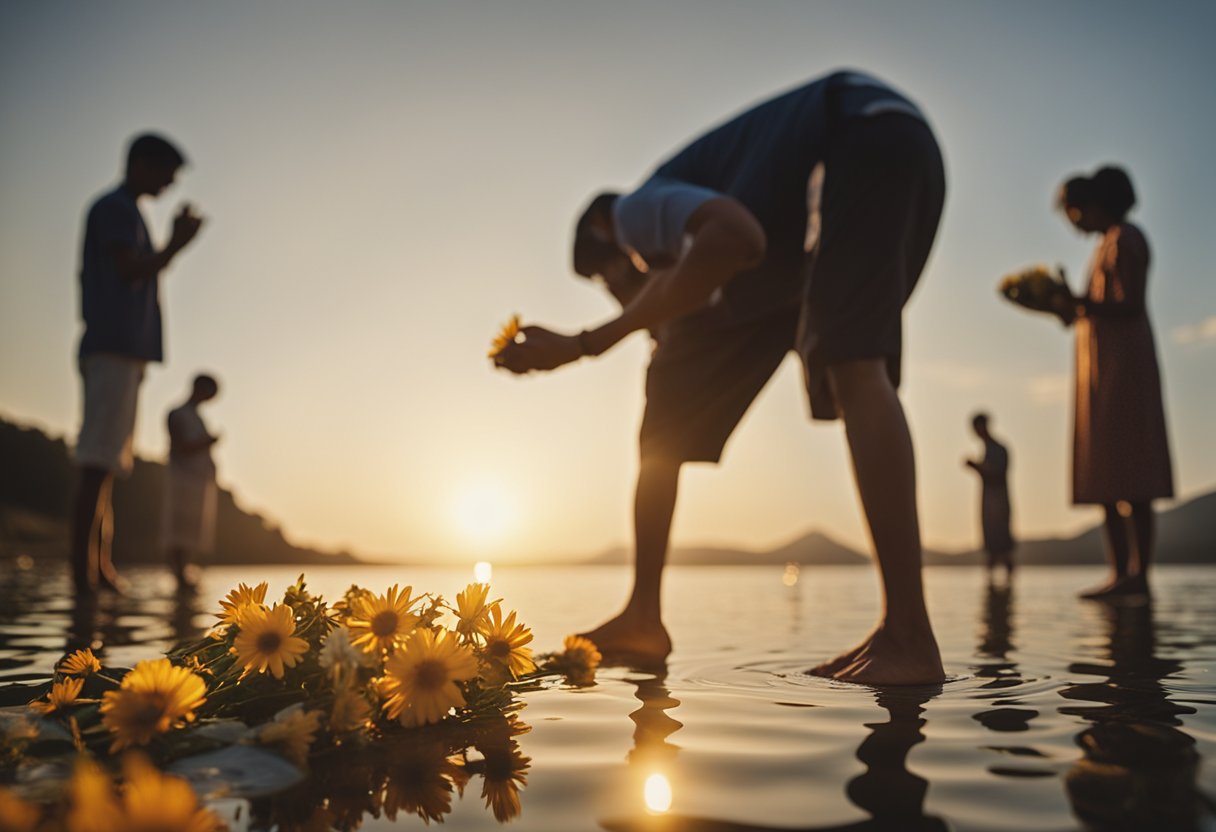
In exploring the rich tapestry of water worship traditions, we find that rituals and ceremonies form the heart of cultural practices around sacred rivers and lakes. These traditions often serve to purify, heal, and unite communities through shared beliefs and practices.
Festivals and Pilgrimages
Kumbh Mela, arguably the most celebrated of these river festivals, draws millions of pilgrims to sacred rivers in India every twelve years. During this auspicious event, devotees believe that bathing in the holy river will cleanse them of sins, leading to salvation. Here, we see a profound example of a river’s power to sanctify and the tremendous scale of communal devotion.
In Nepal, the spiritual significance of sacred lakes such as Gosainkunda is honoured through festive pilgrimages. Defined by treks through stunning landscapes, these journeys culminate in reverent ceremonies beside waters believed to be created by deities.
Purification and Healing Practices
Holy water plays a central role in purification rituals across many cultures. In Christianity, water is a symbol of purity and is instrumental in the rite of baptism, marking one’s entrance into faith. Sacred rivers in Southern Africa, too, have seen water become the focal point of cleansing and worship practices.
Healing practices associated with water transcend mere physical well-being, often representing a form of spiritual therapy. Many traditions regard bodies of water as places where one can be healed of emotional and spiritual ailments, reinforcing the intrinsic value of these natural sites.
By engaging in these time-honoured rituals and ceremonies, we not only honour tradition but also forge connections with the water sources that sustain and purify us.
Symbolism of Water in Religious Texts
In many religious texts, water is endowed with profound symbolism. It represents elements of the divine, embodying notions of purity, renewal, and life itself. For instance, in Christianity, holy water is used for baptism, symbolising the washing away of sins and the rebirth into a spiritual life.
- Hinduism: Rivers, such as the Ganges, are considered sacred and are thought to offer spiritual merit and purification from sins.
- Islam: Water is essential for ablution – a prerequisite for daily prayers to ensure cleanliness before standing before God.
- Judaism: Bodies of water like the mikvah, a ritual bath, are integral for various purification rites.
The spiritual significance of water is versatile, with many faiths attributing healing properties to water. In Buddhism, water is used in rituals to symbolise impermanence, as it flows away and cannot be grasped, just like life’s fleeting nature.
Across different religious beliefs, water is seen as a mediator between the earthly and the spiritual realms, often believed to house divine powers that can influence human lives. For instance, the tranquil waters of a lake might represent peace and clarity in literature and religious parables.
In our exploration, we find that water transcends its physical form to embody spiritual significance across cultures, symbolising aspects ranging from creation to destruction, fertility, and transformation. The reverence for water bodies in religious beliefs underpins their central role in our spiritual and cultural practices.
Cultural Practices and the Environment
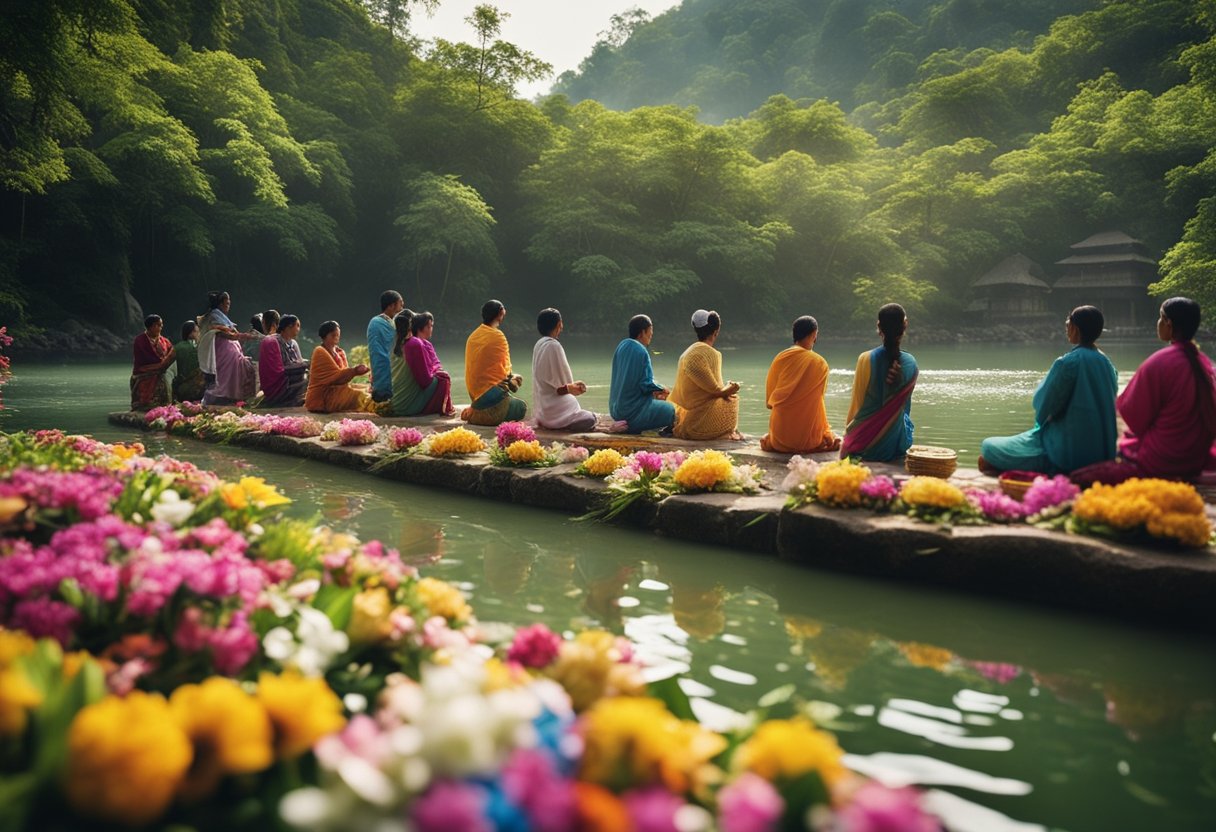
Cultural practices around sacred rivers and lakes often reflect a deep interconnection between communities and the natural environments. We can observe various indigenous and local traditions that incorporate water bodies into their cultural fabric, thus influencing water governance and management. These traditions acknowledge the pivotal role that water plays in sustaining not only human life but also the wildlife that inhabits these landscapes.
Water Management: Traditional water management practices are frequently governed by cultural norms and have often been sustainable. Guided by a wealth of local knowledge, these practices can include seasonal fishing bans or the conservation of surrounding forests to protect watersheds.
- Aesthetic Values: Water bodies are not only utilitarian resources but also sites of immense aesthetic value. The natural beauty of lakes and rivers often intertwines with cultural activities, from artistic expression to religious rituals, enhancing the cultural significance of these sites.
Conservation Efforts: Many cultural groups actively participate in efforts to preserve natural resources. These efforts may include reforestation initiatives, wetland restoration, or campaigning against pollution, all aimed at protecting the environment for future generations.
Environmental Impact: While many traditional practices are inherently sustainable, some may have a negative environmental impact if not managed properly. It is crucial to balance cultural traditions with contemporary environmental considerations to ensure the long-term health of our natural resources.
By weaving together the threads of culture, community, and reverence for nature, we can better understand how to foster an environment that honours both cultural heritage and ecological integrity.
Social and Economic Aspects of Sacred Waters
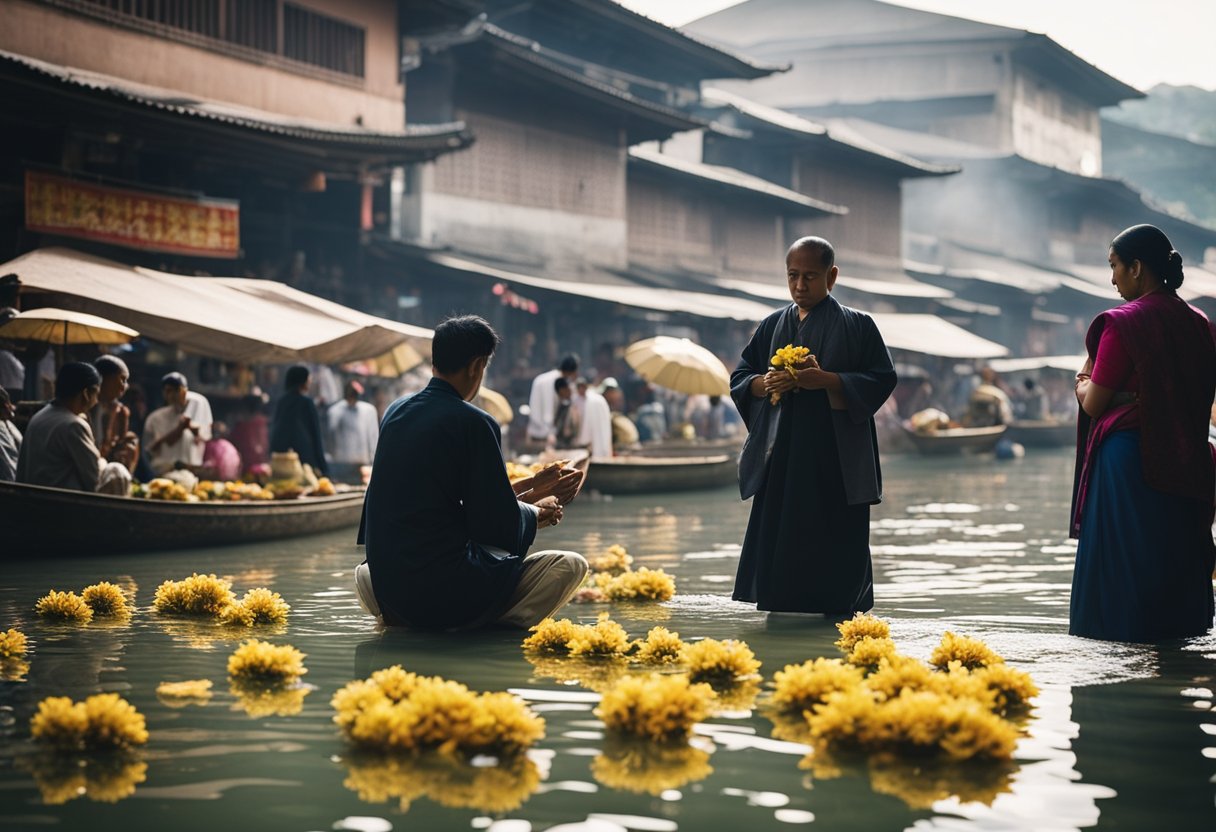
In many regions, sacred waters are deeply intertwined with the social and economic fabric of communities. Sacred rivers and lakes often define territorial boundaries, becoming key elements in the identity and cohesiveness of communities. Sacred sites provide a space for dialogue and decision-making, playing a crucial role in the cultural heritage of a region.
- Ecuador, for example, has integrated respect for nature into its constitution, acknowledging the rights of nature and reinforcing the socio-economic importance of sacred waters within Indigenous territories.
Economically, sacred waters can be both a blessing and a challenge. They often attract tourists to cities and regions, which boosts local economies through tourism and related industries. Here’s a brief look at the impact:
| Sacred Site | Economic Benefits | Challenges |
|---|---|---|
| Ganges River | Boosts tourism; supports fishing and agriculture | Pollution; overuse |
| Lake Titicaca | Cultural tourism; traditional crafts | Resource management; environmental threats |
The relationship between sacred waters and local economies is delicate. On the one hand, these waters must be preserved to maintain their cultural significance and natural integrity. On the other, they hold the potential to support economic growth through sustainable tourism and artisanal crafts. Balancing this dichotomy requires sensitive and informed decision-making to support the needs of the present while protecting the legacy for future generations. We understand, as many tourist platforms like Connolly Cove do, the importance of promoting not only the sites themselves but also the responsible exploration and celebration of cultural heritage.
Legal Rights and Water Bodies as Entities
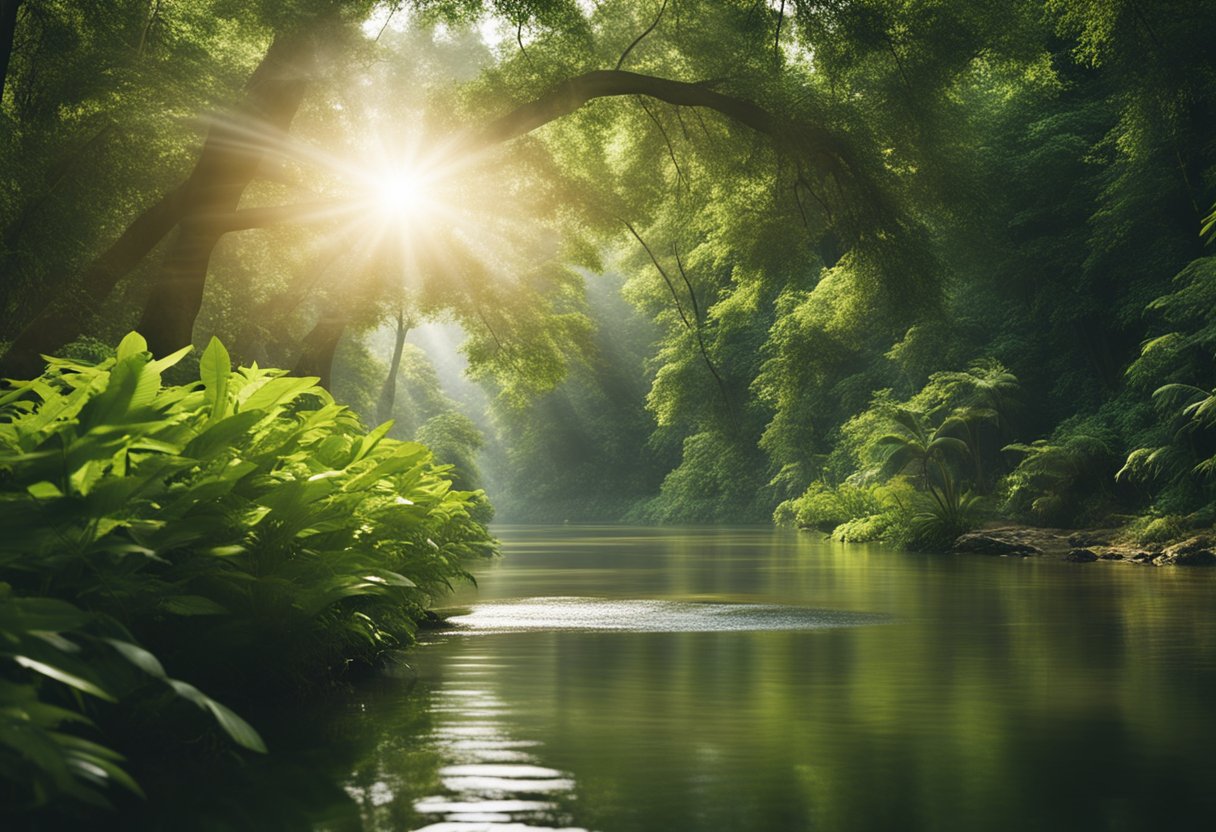
In recent years, there has been a groundbreaking shift in legal systems recognising water bodies as legal entities. This gives rivers and lakes a voice in legal matters, acknowledging their intrinsic value and the rights of nature.
Whanganui River Rights
The Whanganui River in New Zealand stands as a beacon of this revolutionary change. After a long battle, it was granted legal personhood in 2017. This was a historic move that recognised the river as an indivisible and living whole, embodying the values of the local Māori people who view it as their ancestor. The river now has legal rights and can be represented in court, ensuring its well-being and protection.
Ecosystems and Jurisprudence
Across the globe, legal frameworks are evolving to incorporate ecosystems into jurisprudence. In this paradigm, Mother Earth is not just a resource to be exploited but a living entity with rights akin to a human being. Legal personhood for natural entities translates into the right to exist, flourish, and maintain natural cycles, forging a path towards ecological sustainability and respect.
Contemporary Challenges and Water Worship
In recent years, we’ve witnessed a complex relationship unfolding between water worship and contemporary challenges. The global rise in mining activities has, at times, led to conflicts with local communities that hold certain rivers and lakes as sacred. These activities not only disrupt the natural landscape but also can contaminate essential drinking water supplies, infringing upon the spiritual and practical importance of these water bodies.
Energy development projects aimed at harnessing water bodies for hydroelectric power often clash with the cultural practices associated with water worship. The transformation of a sacred river or lake into an energy site can be seen as a desecration, inciting tensions and sometimes conflicts between indigenous communities and developers.
- Mining Impacts:
- Water pollution
- Destruction of sacred land
- Energy Projects:
- Hydroelectric dams
- Risk to cultural sites
Moreover, the struggle to preserve these traditions is exacerbated by the pressing need for water as a resource for growing populations. As such, the sacred bodies of water are often caught in the middle of a tug-of-war between conservationists, who strive to protect these sites’ spiritual significance, and governments and corporations seeking to exploit them for their utilitarian value.
We observe that these issues raise profound questions about how we balance the demands of modern society with reverence for nature and culture. It becomes increasingly clear that any sustainable approach to managing water resources must incorporate the spiritual and cultural dimensions that have been a cornerstone for many communities across the world.
Health, Mental Well-being, and Water Worship
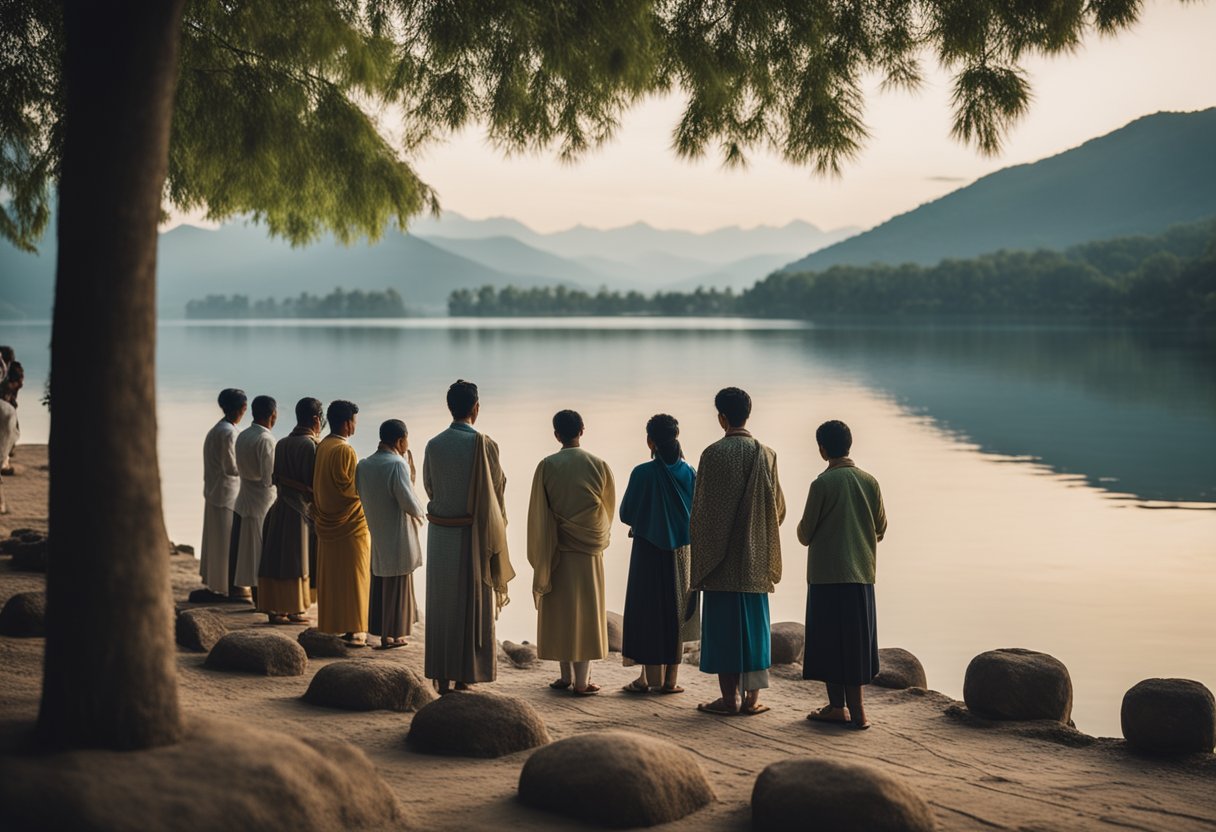
In many cultures, water is deeply interwoven with spiritual practices that have a profound impact on human well-being and mental health. It’s not just a substance that sustains life; it symbolises purification, renewal, and a connection to something beyond the physical world.
- Purification Rituals: Water is often pivotal in rituals meant to purify and renew the human spirit. Immersion in sacred rivers or lakes is believed to cleanse not just the body but also the soul.
- Mental Health: Natural water features like rivers, lakes, and oceans can have a calming effect, promoting tranquillity and reducing stress.
- Symbolic Importance: Water bodies are frequently seen as symbols of life, bounty, and continuity, profoundly affecting community well-being.
The act of worshipping through water signifies a deep respect for its life-giving and sustaining properties. Sacred traditions around rivers and lakes are manifestations of this reverence. For instance, the Ganges in India are considered holy, with millions relying on them for both physical sustenance and spiritual fulfilment.
In summary, we see that the relationship humans have developed with water is multifaceted, encompassing the essential physical need but extending far beyond into emotional and spiritual realms. The lasting traditions of water worship are a testament to its enduring role in societal health and personal well-being.
Conservation and Future Directions
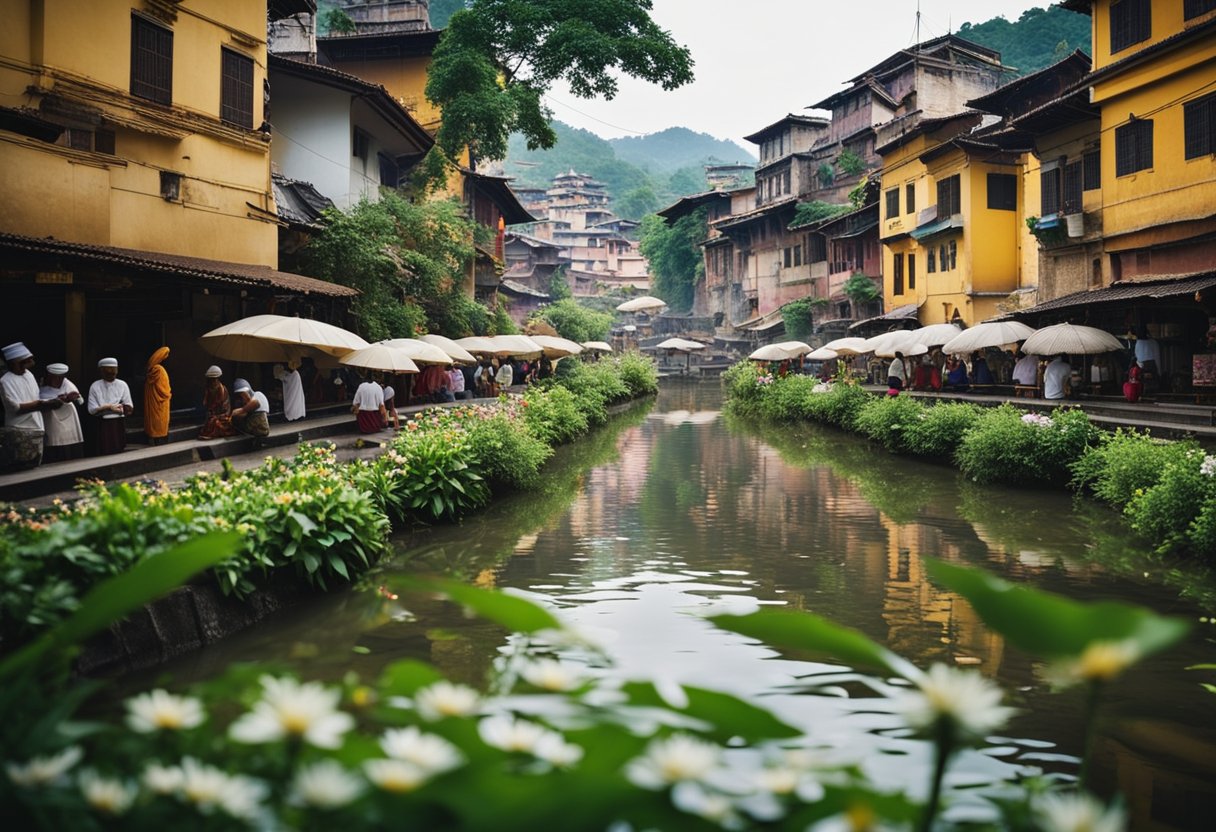
As the guardians of our planet’s precious rivers and lakes, we play a pivotal role in spearheading the conservation efforts that will determine their fate. Recognising these bodies of water as the very source of life, we must adopt sustainable practices to ensure their longevity for future generations.
Our Strategy:
- Implement renewable energy solutions to minimise the impact on these natural sanctuaries.
- Foster community engagement to instil a sense of shared responsibility in preserving our natural resources.
- Collaborate with indigenous communities to integrate traditional knowledge into our conservation tactics.
Action Plan:
- Education: Increase awareness through educational programs that highlight the spiritual and cultural importance of water bodies.
- Policies: Advocate for stronger protection policies and encourage governments to recognise the cultural value of water.
- Technology: Utilise innovative technologies that aid in monitoring and protecting water sources without disrupting their natural state.
By making concerted efforts in these directions, we ensure that the reverence for our sacred waters is not merely a chapter of the past but a continuous narrative. Our commitment to these practices is not just a duty but an honour, serving as custodians of the Earth’s most vital resource.
Frequently Asked Questions

In this section, we address key queries regarding how different cultures interact with and honour water. These are rooted in deep spiritual beliefs and long-standing traditions.
What are common cultural practices involving the worship of water in Hinduism?
In Hinduism, rivers like the Ganges are revered as goddesses, and many faithful embark on pilgrimages to bathe in their sacred waters. Rituals such as Aarti also involve offering prayers alongside riverbanks, and illuminating the water with lamps as a sign of respect.
How is water symbolism understood and integrated in varying cultural beliefs?
Water is often seen as a symbol of purity and life across cultures. For Native Americans, entities like the beaver are considered divine, and specific ceremonies are centred around water as a source of sacred wisdom and guidance.
Could you provide examples of communities that face a daily impact due to the water crisis and their cultural responses?
Communities in arid regions of Africa often have a profound respect for water, seeing it as a precious commodity. In response to shortages, they may perform rainmaking rituals or hold ceremonies imploring divine intervention to relieve droughts.
In which religions is water considered sacred, and what significance does it hold?
Besides Hinduism, water is sacred in numerous religions, including Islam, where it’s used for purification before prayers, and in Christianity, where it represents baptism and renewal. Many Eastern traditions regard water as critical to spiritual cleansing and balance.
How do traditional societies perceive the value and role of water within their cultural practices?
Water is often intertwined with the creation narratives of traditional societies, and its presence and usage are crucial in daily life and rituals. For example, animistic beliefs, such as those among certain African communities, may view bodies of water as living entities with souls warranting veneration and respect.
What are some rituals or ceremonies that exemplify the reverence of water in different cultures?
Rituals like the submersion in mikvahs in Jewish tradition, the Chhath Puja dedicated to the sun god in India, where water plays a central role, and the use of holy water in Christian sacraments all showcase the fundamental and diverse ways cultures revere water.






